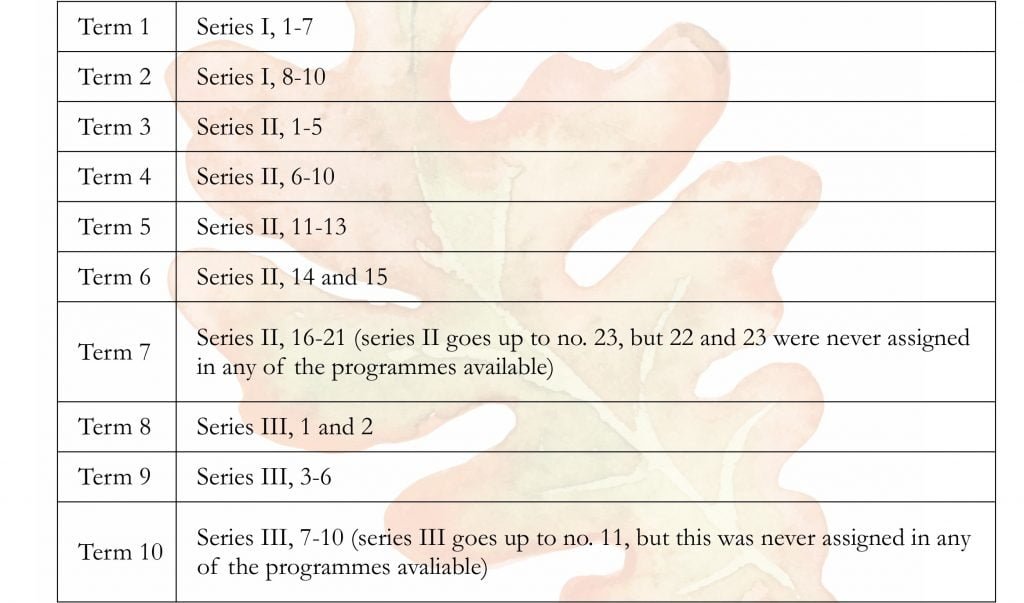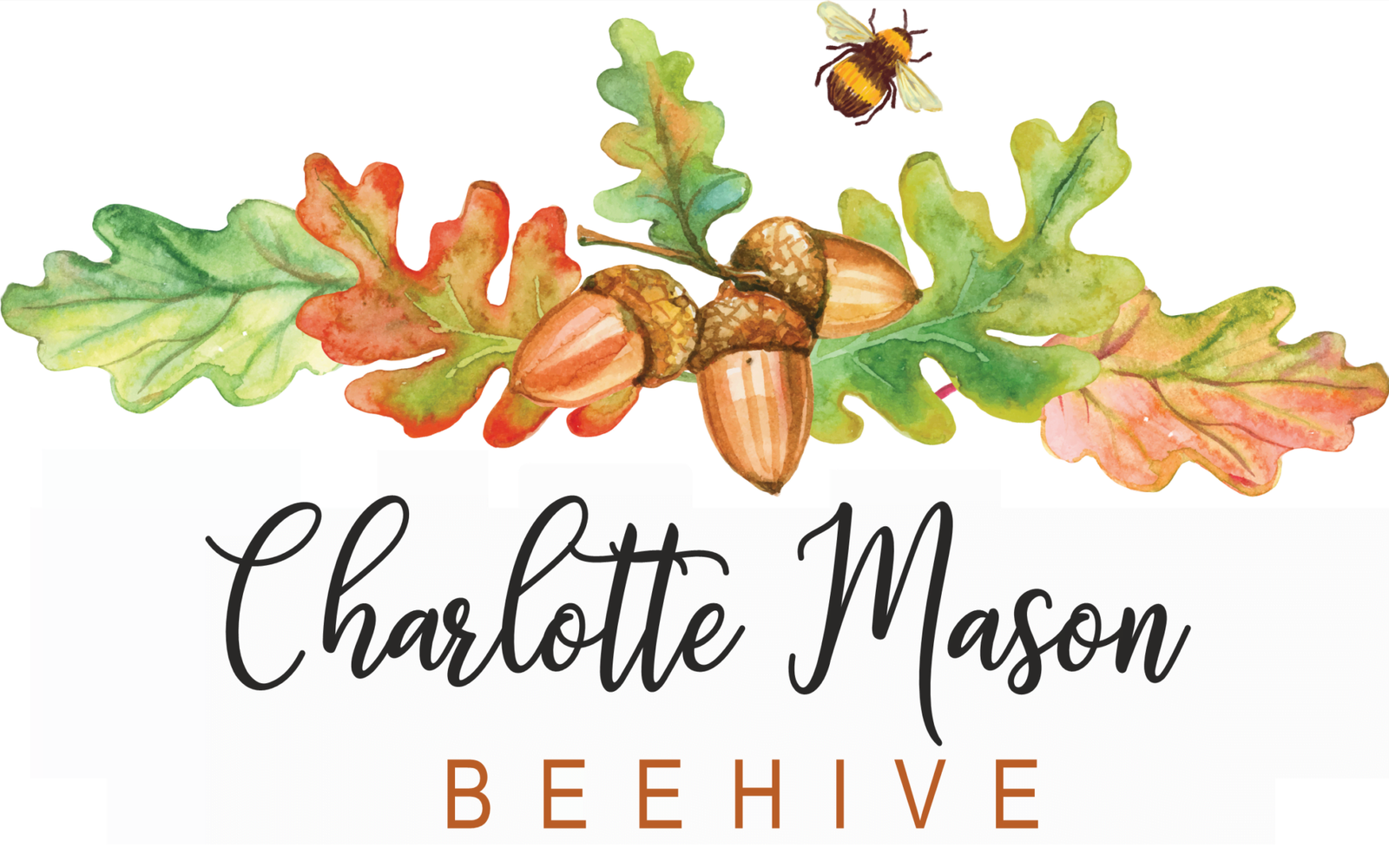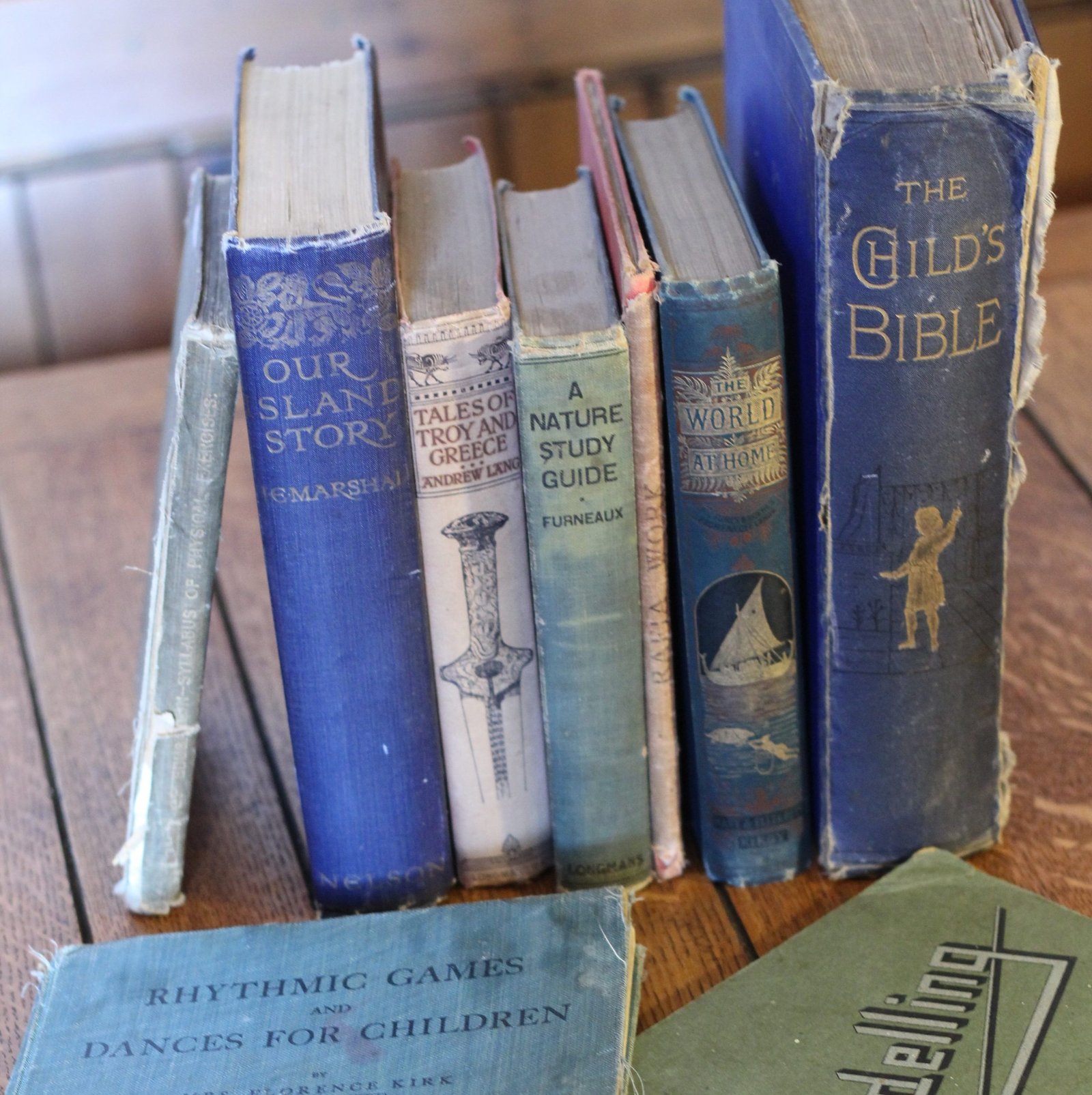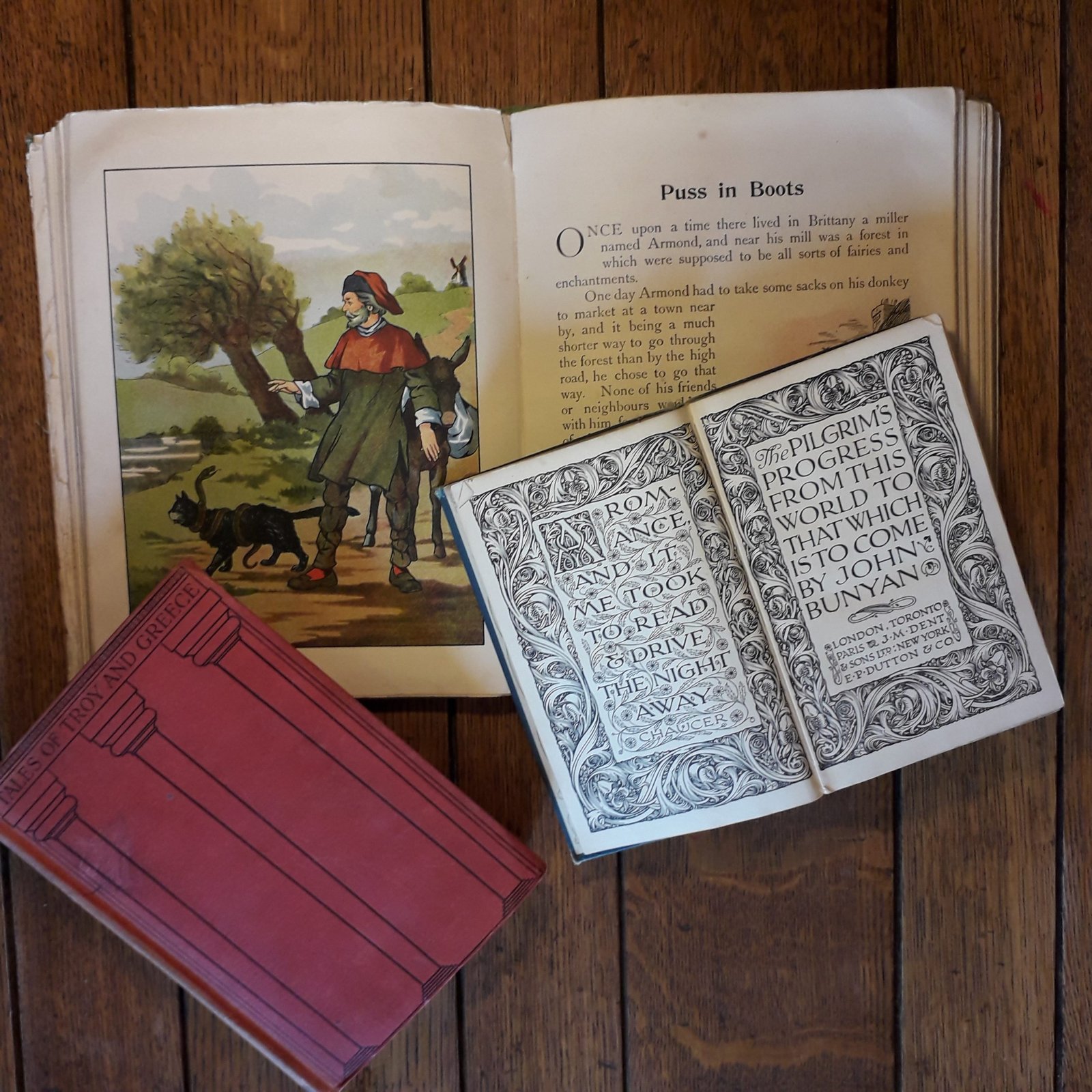“It is not possible to do more than mention two more important subjects––the Handicrafts and Drills––which should form a regular part of a child’s daily life […] The Handicrafts best fitted for children under nine seem to me to be chair-caning, carton-work, basket-work, Smyrna rugs, Japanese curtains, carving in cork, samplers on coarse canvas showing a variety of stitches, easy needlework, knitting (big needles and wool), etc. The points to be borne in mind in children’s handicrafts are: (a) that they should not be employed in making futilities such as pea and stick work, paper mats, and the like; (b) that they should be taught slowly and carefully what they are to do; (c) that slipshod work should not be allowed; (d) and that, therefore, the children’s work should be kept well within their compass.”
[Vol. I, pp. 315-316]
Scheduling
4–5 × 20–30 minute lessons to equal a total of 1 hour 40 minutes per week.((In the 1908 P.U.S schedule, there are scheduled two 20 minute lessons and two 30 minute lessons a week. In the 1928 timetable there are scheduled five 20 minute lessons.)) In addition, handiwork was also undertaken during afternoon occupations.((Handiwork is listed as an afternoon occupation in the ‘Suggestions’ pamphlet sent out with the programmes. There is no quantity of time indicated on the pamphlet; however it seems likely to me that spending 20 minutes once or twice a week was a reasonable expectation.))
[There was also an extra 20 minute lesson first thing on Saturday morning, called Weeks’ Work. Whilst we cannot be absolutely certain what this lesson entailed, it seems likely that this was an extension of the handicraft lessons, and may have either been time for the students to work on their projects from the week, or perhaps was a specific time for students to mend clothes from the wash (as was specified in the programmes for Forms II and up).]
It is significant to note just how much lesson time was devoted to handiwork in the P.N.E.U. For Charlotte Mason, these skills were not just additional extras but essential elements of the wide feast of a living education.
Whilst Handiwork took up a considerable chunk of time in Form I, for Form II upwards there was no longer any morning lesson time allocated; it was solely undertaken in the afternoons. It was important, therefore, that the Form I students established the habit of daily handiwork so that this would carry them through their education and beyond.
Material covered
For the most part, Form I A&B followed the same term by term programme for Handiwork. There were five main categories to the Handiwork lessons, and the students would have several projects running side by side one another throughout the term. It seems likely to me that each handiwork lesson during the week was assigned its own particular handicraft to be worked on during that time, thereby affording equal attention to all the different projects being worked on.
It is also important to note that there was always a point to the handicraft assigned, an end goal, if you will. Every term the students were expected to actually produce an end product, the fruits of their labours, and what this was to be was often specified on the programmes. For example, if the students were assigned Raffia Work for the term’s handicraft, they may have been instructed to “make a set of raffia mats.”
The five specific categories are as follows:
(a) Help in house or garden
Every programme always began under work with the statement, “help in house and garden.” This was clearly an important part of the programme and one we as Charlotte Mason educators can surely rejoice in. Having our children help with chores and carving out time for this daily is perfectly legitimate. There was rhyme and reason to this kind of work, however, and we must be sure our students are careful and conscientious as they carry out their duties; we must train them carefully so that they understand what is to be expected of them.
Often there was a book on gardening assigned, such as The Little Girl’s Gardening Book, or Practical Gardening for Children, by O. Marshall.
(b) Paper modelling
Paper modelling, or Paper Sloyd, has enjoyed a resurgence amongst Charlotte Mason educators in recent years, and just as well because it forms an important part of a Charlotte Mason education. The work of Form I A&B initially differed for this particular handicraft.
The students in Form IB were initially assigned a book called Paper Folding, by H. G. Paterson((This book has now been reprinted by Charlotte Mason Beehive, and is available for purchase in our shop.)), which was worked through on a three term rotation. The students made about 8 models per term from the book as well as two original models along the same lines (in 1925 this book was dropped and the students in IB joined with the book and work IA were doing). The work assigned each term from Paper Folding, was as follows:

The book assigned to IA was Paper Modelling, by M. Swannell((This book has recently been reprinted by Living Library Press and is widely used by modern day Charlotte Mason educators. It is available on Amazon with free postage but has a significantly long shipping time.)). The book progresses in difficulty and the students were generally assigned 2-5 projects a term depending on difficulty. There doesn’t appear to have been a specific rotation for what was assigned when, and students would often begin the next series without finishing the previous one. As there are only six terms in IA it might be an idea to take one series at a time over two terms, without the expectation of necessarily completing it, and anything that doesn’t get done could perhaps be taken up during afternoon occupations. Below is a general outline for how the projects were assigned each term from start to finish.

From 1931 this book was replaced with Paper Cutting and Modelling, by J. E. Tolson. The World of Paper, toy book, by Forbicicchio (IB took the 1st and 3rd group, whilst IA took the 2nd and 4th group), was also listed but this was used in addition to Paper Modelling.
(c) Needlework
Each term the students in I A&B were expected to work on some needlecraft (usually sewing, knitting, and/or crochet) projects. They were assigned The Little Girl’s Sewing Book, and The Little Girl’s Knitting Book, both by Flora Klickmann or they could use Needlecraft in the School, by M. Swanson. The programmes also suggested What shall we make?, by M. La Trobe Foster as a teacher’s reference.
Other needlecraft books used on the programmes were The Little Girls Knitting and Crochet Book, by Flora Klickmann, Pattern Making and Cutting Out, by Mrs E Griffiths, and Needlework for the Youngest Ones (Weldon, no. 123). Some of the later programmes also mentioned supplies needed such as, ‘Knitting: large needles and coarse cotton’.
Often (but not always) the programmes specified a particular project to complete during the term. Some of the projects were taken from a Dryad Handicraft leaflet (specified in brackets). I’ve listed these projects below:
- Crochet a small door mat (leaflet and materials from Messers A. W. Simpson “The Handicrafts” Kendal)
- Make a pair of felt bedroom slippers (Dryad, no. 72)
- Sewing: make Christmas presents
- Sewing: make for example, a kettle holder
- Sewing: make for example, a shoe bag
- Sewing: make for example, a cover for a writing block
- Sewing: make for example, a brush and a comb case
- Knitting: make a mat (Community Knitting, Dryad)
- Make Christmas presents, e.g. Decorative table mats
(d) Handicraft
In addition to the house and garden work, Paper Sloyd, and needlecraft, every term the students were assigned a completely new and different handicraft to learn.
“While speaking of the art training of children, it may be as well to give a word to clay-modelling. Neat little birds-nests, baskets of eggs, etc., are of no use in the way of art development, and soon cease to be amusing. The chief thing the teacher has to do is to show the child how to prepare his clay so as to expel air-bubbles, and to give him the idea of making a little platform for his work, so that it may from the first have an artistic effect. Then put before him an apple, a banana, a Brazil nut, or the like; let him, not take a lump of clay and squeeze it into shape, but build up the shape he desires morsel by morsel. His own artistic perception seizes on the dint in the apple, the crease in the child’s shoe, the little notes of expression in the objects which break uniformity and make for art.”
[Vol. I, pp. 313-314]
Clay modelling was a frequent occurrence on the P.N.E.U. programmes; in fact it was assigned at least once every year, and usually in the summer term (third term of the school year). So, by the time a student moved onto Form II they could have spent three terms on clay modelling. This was clearly a skill Charlotte Mason believed the students should be familiar with. The book almost always assigned for this handicraft was A Manual of Clay-Modelling, by Hermione Unwin, but another book that appeared on the programmes a couple of times was Clay Work, by K. M. Lester. The students were normally required to complete anywhere between 3-6 models during the term.
Raffia work was another common handicraft assigned in Form I. The students often used Rafia work, by M. Swannell, or Raffia work, by E. Mochrie. They were assigned projects as follows:
- Make Raffia mats: Raffia-craft (Weldons, no. 30)
- Make bags or cushions in raffia: Raffia-craft (Weldons, no. 30)
- Raffia: make a set of raffia mats (Dryad leaflet, no. 60)
- Raffia Work: make Christmas presents
Another frequent occurrence in the programmes was Rug making. Below are the projects which were assigned to the students.
- Smyrna Rug work
- Indian Mats (Dryad Leaflet no. 18)
- Rugwork (Weldon’s no. 77)
- Rugmaking on canvas, children could work together at small doormats
- Make a “Locker” rug. See the Country Woman’s Rug Book, by Ann Macbeth, pp. 8-15
Toy making was another common handicraft assigned in Form I. The students were usually assigned one of the following books:
- Model Railway Building, by H. McKay
- The Play-work Book, by Ann Macbeth
- Toy Making, by Bertha Eden
Other handicrafts assigned in the programmes on a much less frequent basis were Stencilling (Dryad leaflet, no. 22), (IB only) Coloured Paper Work (Dryad leaflet), and Felt work: Cut out and applique animals, etc. (Dryad 59 & 72).
(e) Charity
Charity work and service is an important part of a Charlotte Mason education and each term the students were expected to use their skills to serve and bless others, particularly the less fortunate. The charity favoured by the P.N.E.U. appears to have been the “Save the Children” Fund, and the students were often required to in some way offer service to this organisation, even by putting on a play! Below is listed all the ways in which charity and service was indicated under Work in the P.N.E.U programmes.
- Make Christmas presents
- Make Christmas presents and gifts for a Christmas tree for poor children.
- Help the “Combined Hospital Appeal” Fund
- Help the “Save the Children” Fund
- Help in a pageant for the “Save the Children” Fund
- Help the “Save the Children” Fund e.g. act a play from Plays in Rhyme for the Little Ones, by M. L. Darvell and G. M. Tuffley
- Help the “Save the Children” Fund – Seven Little Plays for Children, by R. Fyleman, or for IB, With Pipe and Tabor
Other: Plays and Scouting
As an aside, there were occasionally plays assigned for the students. Scouting was also mentioned; however generally speaking one would find this outdoor part of the programme listed under ‘Natural History’ or ‘Geography’.
- “PUS” or “Guiding” tests
- Eight Plays for Little Ones, by Rose Fyleman,
- or Form-room Plays (for intermediate)
- Plays for acting: The Mulberry Bush, by V. M. Methley
Suggested Teacher Resources
Several programmes held the note, “Teachers will find valuable help in the teaching of Drawing and all handicrafts in the following: Drawing, Design and Craftwork, by F. J. Glass and Applied Art, by Pedro Lemos. It is not advisable to follow stereotyped courses.”
Further Reading
Notes of Lessons: Clay Modelling, Class I
Notes of Lessons: Basket-Work, Class Ib
Notes of Lessons: Carton Work, Class Ia
Sloyd Resources (with video lessons)
The Living Principles of Sloyd, by Brittney McGann
Teaching Paper Sloyd
A Delectable Education, Episode 59: Handicrafts
A Delectable Education, Episode 81: Sloyd: An Interview with Brittney McGann
Printables
Footnotes







